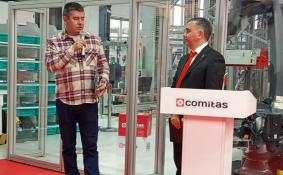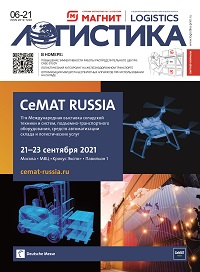Scientific & Practical Journal

Editorial News
Dear readers! We are pleased to present to you the eleventh issue of the journal in 2025. There are a lot of relevant and useful materials in the issue, which, hopefully, will not be ignored.
Dear readers! In September the CeMAT RUSSIA exhibition was held, which showed everyone that innovations and robotics are increasingly penetrating the logistics industry. We can safely say that many technologies are tested here, and only then they go out into the world. However, it is not only CeMAT RUSSIA that demonstrates the prevalence of the digital agenda.
Dear readers! This is the ninth issue of the journal, which turned out to be very rich and diverse. Traditionally, the issue is opened by an analyst. The material by Alina Nasyrova from the Market Guide Agency, dedicated to investments in warehouse complexes in Russia, recalls the importance of developing logistics infrastructure for the integrated development of regions.
PHOTO OF THE WEEK
CITATIONS
«Logistics» Journal № 6 / 2021
WAREHOUSE. INVENTORY MANAGEMENT
Optimization of the route of unmanned aerial vehicles when used in a warehouse with genetic algorithms
Annotation. The paper examines the current trends in the development of logistics systems, taking into account the technologies of Industry 4.0. One of the current trends is the use of drones in warehouses for inventory and delivery. In the article proposes a model of a warehouse with the use of an unmanned vehicle – a robot cart. This article describes the search for the optimal route of an drones using genetic algorithms. Its application allows you to quickly and accurately calculate the required path. For the solution, the program code is written in Python using the Matplotlib library and Orttools. The result of the program is the minimum route of the robot. The developed model can be used in various enterprises.
Key words. Drones, genetic algorithm, Industry 4.0, logistics systems.
Annotation. The article describes the case of improving the distribution center organization with the help of effective gate control. It provides four alternative scenarios and evaluates the best ones.
Key words. Warehouse management, gate strategy on a distribution center, cost reduction, logistics, supply chain management.
TRANSPORT. TRANSPORTATION
Logistics outsourcing in railway transport in the OSZhD countries
Annotation. The article contains statistics of freight transport in the OSZhD transport corridors passing through the territory of Russia are given, new forms of employment are described – outsourcing, outstaffing, personnel leasing, etc. In addition to great opportunities, there are also problems that can be solved by making changes to the legislation.
Key words. Transport corridor, statistics, forms of employment, outsourcing, outstaffing, personnel leasing, labor relations.
PROBLEMS AND OPINIONS
Problems of digital transformation of logistics systems and supply chains
Annotation. The article considers the main stages of digitalization of economic processes, systematizes the stereotypes of the concept of «digital economy». Based on the analysis, new business practices are systematized. The factors that determine the complexity of digital transformation in logistics systems at all levels are identified. The task of process integration of information systems of logistics companies is formulated. The conclusion is made about the prospects of using process-oriented integration of information systems in logistics.
Key words. Digital transformation, Industry 4.0, information systems integration, process approach, digital models of business processes, information technology.
Annotation. The article lists the main properties of the system, indicates the need to add such properties as the presence of a control element (subject) and purposefulness. The author's definitions of the logistics system in general and the state logistics system in particular are given. It is clarified that the state acts as the managing entity of the state logistics system.
Key words. System, system properties, managing entity, logistics system, state logistics system.













